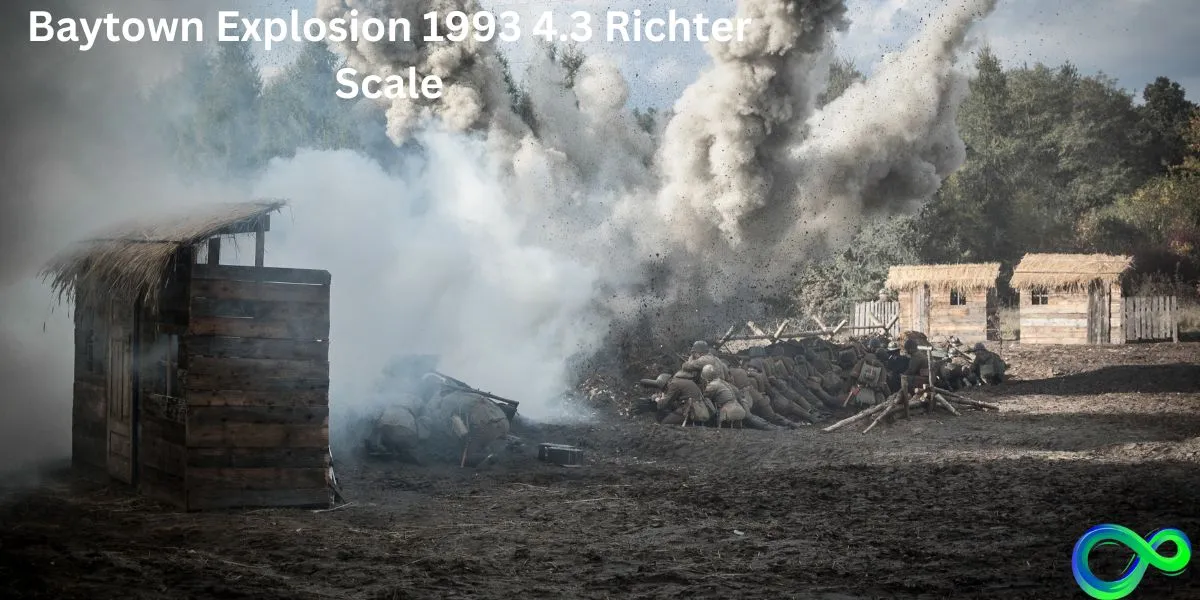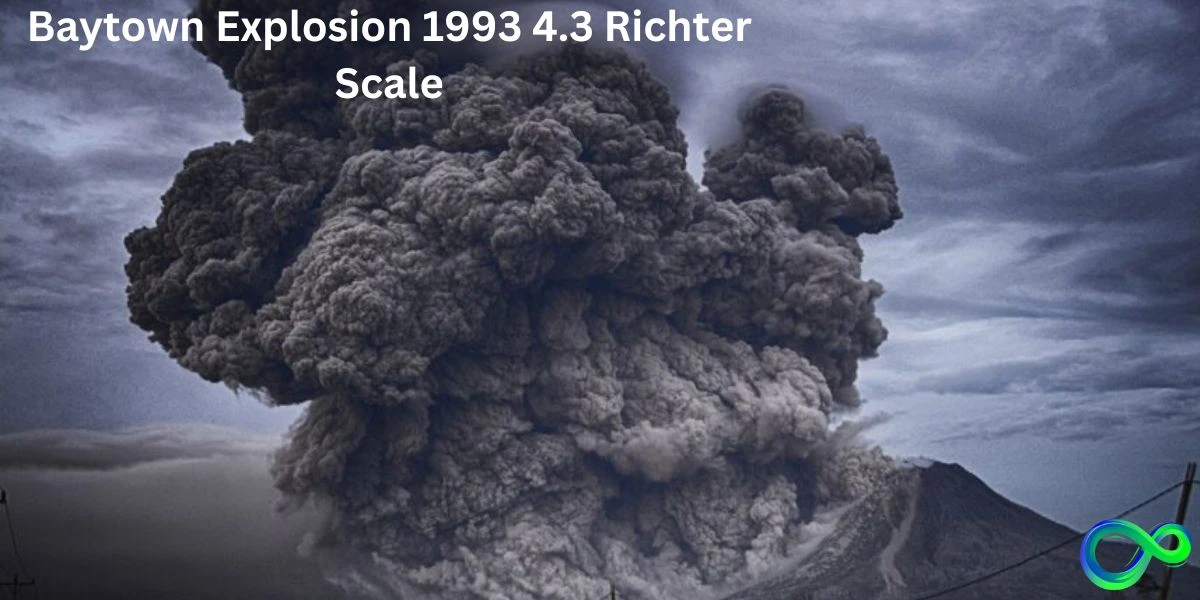Baytown Explosion 1993 4.3 Richter Scale: A Catastrophic Event Remembered
A devastating explosion at a chemical facility shook Baytown, Texas, early on March 23, 1993. This incident would become one of the most catastrophic industrial mishaps in American history. The 1993 Baytown Explosion, which had a Richter Scale of 4.3, left behind significant damage, fatalities, and a long-lasting effect on the neighborhood.
Although it was first thought to be an earthquake, the tragedy’s actual cause—an industrial accident—would soon be revealed, raising serious concerns about chemical industry safety, supervision, and readiness for disasters.
Also read:
CSOMO Projector Gaming Mode Configuration & More
1959 Oliver 550 tractor air filter replacement

What Caused the 1993 Baytown Explosion?
Baytown was home to a number of significant industrial facilities in the early 1990s, such as chemical factories and oil refineries. An unexpected explosion rocked this industrial center on a calm day in 1993.
Experts believe it was probably caused by industrial elements like gas or chemical leakage, which may have generated a highly flammable environment, although if particular facts are still unclear.
Combustible materials may unleash enormous amounts of energy when they burn, causing explosions that can mimic tiny Richter-scale earthquakes. Because of the industrial activity and potential safety lapses, Baytown was vulnerable to this kind of explosion.
How Strong Was the Explosion? Understanding the 4.3 Richter Scale
On the Richter scale, the Baytown explosion was recorded at 4.3. Although it is frequently applied to earthquakes, this measurement is also applicable to strong explosions. In earthquake-prone locations, an earthquake with a Richter scale value of 4.3 is considered “light,” meaning it is felt but usually doesn’t result in significant structural damage. This threshold, however, can be disastrous in the event of an industrial explosion, particularly if there are combustible products or populous areas nearby. Similar to natural seismic occurrences, explosions that register on the Richter scale signify a significant release of energy and ground movement.
To put it in context, an explosion of magnitude 4.3 may shake buildings, rattle windows, and produce a lot of noise. It also causes a tremor that is felt across a large region. Residents of Baytown were shaken and in a state of terror and panic as a result of the explosion, which had a vibration similar to a small earthquake.
What Damage Did the Explosion Cause?
Buildings close to the bomb site sustained structural damage as a result of the Baytown explosion. The shockwave caused doors to rattle, windows to break, and items to fall off shelves. Roads, several residences, and other industrial facilities were damaged and needed to be repaired very away. In addition to causing structural damage, the blast’s shockwave raised safety concerns.
As word of the explosion spread, nearby communities realized the possible risks and grew more cautious about being close to such dangerous industrial facilities.
Key Findings
- Cause of the Explosion: Flammable gasses were released as a result of a mix of procedural errors and mechanical malfunctions, and they caught fire.
- Impact: Several factory workers were killed in the explosion, more than 100 people were injured, and more than 100 nearby buildings were destroyed.
- Response: While federal and state groups began their inquiry, emergency services moved fast to control fires and handle the aftermath.
- Regulatory Changes: New precautions and training came from the incident’s impact on the chemical industry’s safety procedures and laws.
- Community Recovery: Projects related to disaster preparedness and providing emotional support for
The Impact on Families
Families in Baytown were severely impacted by the blast. Some faced long-term health problems as a result of exposure to toxins released during the awful event, while others lost family members. In the aftermath, support groups formed to provide a secure setting where people could talk about their experiences and find comfort in knowing that they were not alone.
The Importance of Safety Regulations and Prevention Measures
Safety rules are very important in industrial settings. They aim to protect the environment, the community, and employees from possible risks.
The 1993 Baytown explosion is a sobering reminder of what can happen when safety precautions are disregarded. This event made clear how urgently all industries need to implement strict safety regulations.
Regular equipment maintenance and inspections should be part of preventive measures. Equally crucial is providing workers with the right training on how to handle dangerous items.
Furthermore, to guarantee prompt action in times of disaster, emergency response plans need to be created and routinely practiced. Another important factor is public awareness; communities should be prepared for such crises.
Every industrial accident serves to emphasize how important these rules are. Putting safety first not only reduces risks but also drives accountable in businesses.
Immediate Impact and Casualties
Right away following the incident, the factory exploded in flames. Numerous workers lost their lives in the accident, while numerous others were hurt in the explosion or as a result of the fire and poisonous fumes that followed. The dangerous chemicals and intense heat made the situation extremely difficult, despite the tireless efforts of firefighters, emergency responders, and plant workers to contain the fire.
Two workers are reported to have died in the explosion, while at least thirty others were hurt, many of them from burns, smoke inhalation, and trauma. Reports on the precise number of casualties vary. Due to the dispersion of hazardous chemicals into the air and adjacent waterways, the explosion also seriously damaged the ecosystem, impacting both the local area and the larger population.
Legal and Regulatory Changes
The lawsuits were filed against Mobil Oil and other accident participants in the years after the explosion. Lawsuits for environmental damages, personal injury, and wrongful death were brought by victims and their families. Some victims received compensation as a consequence of the legal proceedings, although many contended that the settlements were inadequate considering the tragedy’s scope.
Also, the explosion led to modifications to federal and state laws. The incident specifically prompted the Clean Air Act’s Risk Management Program (RMP), which requires chemical facilities to create and carry out strategies to reduce the risks of unintentional releases of dangerous chemicals. The chemical industry’s safety procedures were also reexamined, with a focus on risk assessments, emergency planning, and stricter safety regulations.
The damage and destruction caused by the earthquake
With a magnitude of 4.3 on the Richter scale, the 1993 earthquake was surprisingly powerful. Baytown’s buildings trembled dramatically, causing structural problems throughout the area.
The strain caused houses that had stood for decades to collapse. Debris filled the streets, and broken glass gleamed menacingly amid the mayhem.
Roads, bridges, and other vital infrastructure were severely damaged. Emergency personnel found it difficult to move through blocked roads while they evaluated the damage.
Storefronts were rendered unusable overnight, resulting in significant losses for local businesses. Numerous livelihoods abruptly disappeared, forcing families to struggle with future uncertainty.
There was an intangible cost in addition to the physical devastation: inhabitants were forced to leave their once-comfortable houses in search of safety. Long after the immediate impact of this earthquake had faded into memory, its reverberations would continue to be felt.
Remembering the Baytown Explosion Today
The 1993 Baytown explosion is still remembered as a pivotal moment in the community’s history, serving as a warning of the potential for industrial mishaps and the significance of safety. Many locals who were directly affected by the explosion can still recall their feelings of terror and bewilderment on that day. The occasion still serves as a teaching tool, highlighting the necessity of ongoing safety enhancements in sectors that handle volatile substances.
The tale of Baytown strikes a chord with locals as well as other communities close to industrial hubs, highlighting the importance of preparedness and safety in any location where flammable products are handled.
When to Seek Medical Help?
It can be prudent to see a healthcare professional if appetite loss persists despite lifestyle changes (Baytown Explosion 1993 4.3). A chronic lack of appetite may indicate underlying medical conditions that need to be treated by a physician. It may be necessary to seek treatment for symptoms like exhaustion, abrupt weight loss, or digestive issues.
Historical Context and Seismic Activity
The 1993 explosion shows how industrial events can mimic natural seismic occurrences, even though Baytown isn’t known for having seismic activity. Because of the energy they release, these events are classified differently from natural earthquakes yet are still recorded by seismic networks. In comparison to natural earthquakes like the 7.8 Guam earthquake that same year, which resulted in significant damage and deaths, a 4.3 magnitude event is not light.
The Baytown explosion’s seismic scale registration shows how human activity and nature monitoring systems are linked. Better safety protocols and catastrophe preparedness plans result from authorities and scientists being able to differentiate between natural and man-made quakes.

Legislative and Regulatory Changes
Security measures in the chemical industry came under more scrutiny as a result of the Baytown explosion. The Environmental Protection Agency (EPA) and the Occupational Safety and Health Administration (OSHA) tightened their laws in the years after the disaster to improve chemical handling procedures and worker safety. In order to ensure more thorough inspections of chemical sites and to improve emergency response ability, new legislation was introduced.
Firms also started to spend more on safety technologies, such as sophisticated monitoring systems that could identify gas leaks and notify staff before things got out of hand.
Remembering the Victims and Heroes
The community was forever altered by the 1993 Baytown Explosion, which had a Richter Scale of 4.3. Friends grieved together in shared sadness when families lost loved ones. Every name placed on memorials signifies not just a victim but also a brief tale.
Heroes came in the midst of the mayhem. While others provided sanctuary to those in need, first responders went towards danger. Their bravery demonstrated humanity at its best during an unimaginable disaster, shining brightly against a backdrop of misery.
Since that dreadful day, vigils have been a tradition. As people gather to commemorate both lives lost and lives saved, candles softly flicker. Stories are told, tales of tenacity and fortitude that will continue to motivate generations to come.
They ensure neither heroes nor victims will disappear from our history or emotions. They serve as a reminder of the frailty of life and the ability of a united society to triumph over sorrow.
The Explosion and Its Immediate Aftermath
One of the biggest oil refineries in the nation was the site of the 1993 Baytown explosion, which had a Richter scale of 4.3. The blast’s enormous shockwave struck, and people miles away from the epicenter felt its impact.
The incident registered 4.3 on the Richter scale, a measure typically reserved for minor earthquakes. But in this instance, industrial failures and human error were the cause of the seismic activity.
After the 1993 Baytown explosion, which had a Richter value of 4.3, the immediate aftermath was absolutely devastating. Flames consumed much of the refinery, and emergency personnel quickly became overwhelmed by the scale of the disaster.
Worried about toxic fumes and potential aftershocks, many residents of Baytown and the surrounding areas evacuated as thick plumes of smoke filled the air. While rescue crews toiled diligently to find the missing and injured, the families of refinery employees suffered a period of anxiety and uncertainty.
How People Felt During the Blast?
It was a startling and unforgettable event for the people who lived in Baytown. Many people reported hearing a loud, thunderous sound echo across the city, accompanied by a strong vibration that shook homes and buildings. Some initially believed the boom to be an earthquake, and others described it as abrupt and confusing. The explosion was strong.
sufficient to make everyone start, and several of them hurried outdoors to see out what had happened. Residents remember the moment as a frightful, perplexing experience, and the loud noise and ground tremor left a lasting impression.
Lessons Learned and Future Prevention
An example of the significance of preventive measures and industrial safety is the Baytown explosion. Important lessons consist of:
1. Importance of Robust Safety Infrastructure
New safety precautions must be implemented by industries, particularly those that handle dangerous products. This entails routine equipment maintenance, safety examinations, and making certain that every employee has received emergency response training. Better technology and risk-reduction practices were probably applied more quickly as a result of the 1993 incident.
2. Monitoring and Early Warning Systems
The identification of such risks is facilitated by the integration of monitoring systems, such as air quality monitors and seismic sensors. By integrating these devices with nearby emergency services, timely notifications may be sent, enabling faster reaction times and reducing the damage to property and human lives.
3. Collaboration Between Public and Private Sectors
Examples like as the Baytown explosion emphasize how important it is for businesses, government agencies, and emergency services to work together effectively. Partnerships between the public and commercial sectors can improve availability, expedite communication in emergency situations, and ensure resources are available when needed.
Conclusion: Baytown Explosion 1993 4.3 Richter Scale
The 1993 Baytown explosion serves as a sobering reminder of the possible risks connected to industrial activities. The neighborhood suffered severe damage and destruction as a result of the 4.3 Richter scale event. It draws attention to both the short-term and long-term effects that can have an influence on people and local economies.
We can try to reduce the hazards that come with working in industrial settings by emphasizing safety procedures, making technological investments, and encouraging a culture of awareness among employees.
Recollections of such events serve as a catalyst for continuous discussions over safety regulations and business accountability for safeguarding communities and workers.
The Baytown explosion is an important event that influenced industrial safety regulations for many years to come. In order to move forward, businesses and regulatory agencies must be dedicated to creating safer working environments for all parties.
FAQs: Baytown Explosion 1993 4.3 Richter Scale
Here are some FAQs for Baytown Explosion 1993 4.3 Richter Scale. If you have more questions, feel free to reach out through our Contact Us page.
1. How many people were affected by the explosion?
More than 100 people, including local residents and plant personnel, were hurt, and some workers lost their lives.
2. What measures were taken after the explosion?
After an examination, regulations were changed to enhance safety procedures in the chemical business. Initiatives for catastrophe preparedness and recovery were also a community priority.
3. What lessons were learned from the Baytown explosion?
4. What safety measures were implemented after the explosion?
Safety procedures in Baytown’s industrial facilities were probably reviewed as a result of the 1993 explosion. To avoid such disasters, businesses and government organizations like OSHA might have implemented more stringent safety regulations, such as routine inspections, emergency drills, and enhanced monitoring systems.
5. How strong was the Baytown explosion in terms of magnitude?
On the Richter scale, the explosion had a magnitude of 4.3. Our body uses a significant amount of energy, releasing it with enough force to be felt in nearby areas and recorded as a seismic event, though it is less intense than a natural earthquake.













One thought on “Baytown Explosion 1993 4.3 Richter Scale”